
Culinary careers are sizzling again as the hospitality and restaurant industry bounces back from the pandemic and seeks to fill the positions vacated during the COVID-19 downturn. Chaffey College is doing its part to get more cooks in the kitchen.

By Kris Lovekin / Inland Empire/Desert Regional Consortium
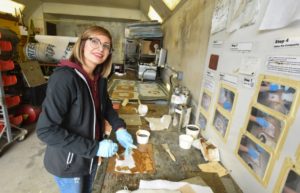
Jessica Vasquez works on composites in aviation maintenance / Photo by Kurt Miller
Rancho Cucamonga – April 2018. Small hands and the ability to fit into small spaces may be a resume booster for Ontario resident Jessica Vasquez. At 25, she has made her way to Chaffey College in Rancho Cucamonga, where she is studying Aviation Maintenance.
It is not what she expected to be doing. At Fontana High School she was positive she would be a nurse in an emergency room. “I like the adrenalin,” she said. But she spent some high-stress hours in an E.R. during a family crisis and suddenly the reality of nursing set in. It was terrifying. She did not know if she could work with patients knowing that they could die at any moment.

Joy Haerens, Dean of Business and Applied Technology / Photo by Kurt Miller
Instead, she took a job in shipping and receiving in a business that made airplane parts. She was fascinated with the hydraulic systems that were critical to keeping the plane in flight. “It amazed me that such a small little part had so much power,” she said. “I felt excited, amazed, and in awe.”
Now she is part of a tradition of excellence at Chaffey College, where aviation maintenance graduates consistently score well on the required tests given by the Federal Aviation Administration. Chaffey ranks first in the Western region for success on that test, and that translates into good job prospects for people in the program.
They seem to know it. Students, whether in their 20s or their 40s, had a goal and specific company in mind. Many of them had already scheduled job interviews. That connection to the industry is one of the requirements for the state funding known as “Strong Workforce,” which can be spent on curriculum, equipment or faculty that will help prepare students for jobs available in the local area.
“A student who struggles may drop out, said Dean Joy Haerens, dean of Business and Applied Technology. “But if they are looking at that job, they persevere.”
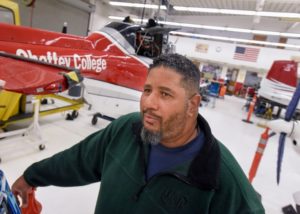
Aviation Program student, Mark McKinney / Photo by Kurt Miller
That was clear in the aviation hangar.
Airplane maintenance is still a male-dominated field, but faculty at Chaffey said that is changing.
“Women are patient,” said Jack Little, one of the instructors in the aviation program. “They have smaller hands. They can squeeze into smaller spaces. Some employers want to hire women for that reason.”
The faculty members organize field trips to the repair hangers of major airlines. Other possible employers are companies that work with the military, such as General Atomics. One of the part time instructors works there and can verify that the training is exactly matched to the company’s needs.
Vanessa Thomas, an associate dean at Chaffey who supervises the Strong Workforce funding, said the next certificate that will be offered through Aviation Maintenance will prepare students to repair, inspect and diagnose unmanned aerial vehicles, commonly known as drones. The new program will start in the fall of 2018.
She said she likes the flexibility of the $200 million allocated to California’s community colleges each year. “It can pay industry leaders to teach for the community college, or it can pay them to offer training to our current faculty. “We get to choose, based on what works best in each program,” Thomas said.
Once a month, the community colleges hold regional Strong Workforce meetings to share resources and ideas, and in that way the money is working to reduce duplication. “If we like what they do, we can ask if we can share that curriculum,” Thomas said. “We want each college to be successful. We want our students to be successful in current industry jobs.”
A brand new Chaffey College program in robotics will prepare students for careers in automation, for example, distribution centers that are ubiquitous across the Inland region of San Bernardino and Riverside counties. “The first round of funding made our welding programs stronger, because that was a priority for our industry partners,” Thomas said.
In the fall of 2017 Chaffey College started offering a “Facilities Management” program to train students for jobs managing large event centers, such as the Staples Center in downtown Los Angeles. “It was requested by industry and we are the only public community college in the state of California offering this so far,” Thomas said.
“The median salary for facilities managers is $91,000 per year,” Thomas said. There are 3,200 job openings each year. The baby boomers are retiring and there are not enough qualified applicants to fill those positions.” Research indicated a dire need for a certification program.
Thomas said, “We are going to fill that gap.”
The talk of high salaries caught the attention of 52-year-old Trina Lujano, who comes to Chaffey from her home in the high desert of San Bernardino County.
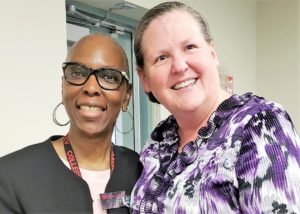
Associate Dean Vanessa Thomas, left, and student Trina Lujano are excited by the opportunities of Facilities Management at Chaffey College in Rancho Cucamonga
Born and raised in Ontario, her most recent job was as a process server for attorneys and others. She knew she had to get more training but she did not know in what field until Associate Dean Thomas handed her a flyer about Facilities Management. One of the benefits of the program, she said, is that a student can specialize in lighting, or space management, or event planning, or accounting, or construction or project management.
“We have people who range from 18 to 52,” Lujano said. “We have all walks of life. We have people who come from HVAC and construction. We have other people who have done Quality Assurance Work.”
Lujano recruited her husband to join her. They have three sons and she is gradually convincing them as well. “I tell them, ‘You take what you love and you specialize in that.’” she said. “My younger son likes construction. My older son likes IT and my middle son, we don’t know yet.” Lujano still has one more year of training and an internship before she is ready for that $90,000 annual salary. “But I could start off lower and work my way up.”
To help with networking, faculty member instructor Phyllis Meng suggested that the class start a student chapter of International Facilities Management Association (IFMA). Meng worked 28 years in the field and she brings in guest speakers who have direct knowledge of best practices.
Lujano, who serves as the president of the student club, is a true believer. “If I could go to every classroom and tell them about facilities management, I would,” Lujano said. “It is recession proof. You are not wasting your time.”
———————
Strong Workforce Program: To develop more workforce opportunity and lift low-wage workers into living-wage jobs, California took a bold step in 2016 to create one million more middle-skill workers. At the recommendation of the California Community College Board of Governors, the Governor and Legislature approved the Strong Workforce Program, adding a new annual recurring investment of over $200 million to spur career technical education (CTE) in the nation’s largest workforce development system of 114 colleges. For more information about Strong Workforce, please visit: http://doingwhatmatters.cccco.edu/StrongWorkforce/Overview.aspx

Culinary careers are sizzling again as the hospitality and restaurant industry bounces back from the pandemic and seeks to fill the positions vacated during the COVID-19 downturn. Chaffey College is doing its part to get more cooks in the kitchen.
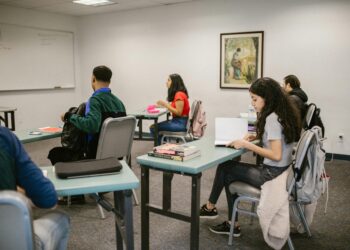
Dual Enrollment (DE) is catching on as students and their families recognize the advantages of earning college credit while still working towards high school graduation. But students aren’t the only… Read More – Good News for Community Colleges: Dual Enrollments Are on the Rise
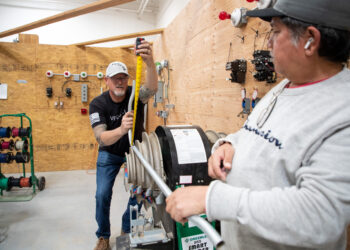
Enrollment in courses not offering credit toward a degree or certificate are outpacing for-credit programs in some states (Fed Communities). And it’s no wonder. With the convenience, minimal time commitment,… Read More – No Credit, No Problem: Noncredit Courses Gain Steam